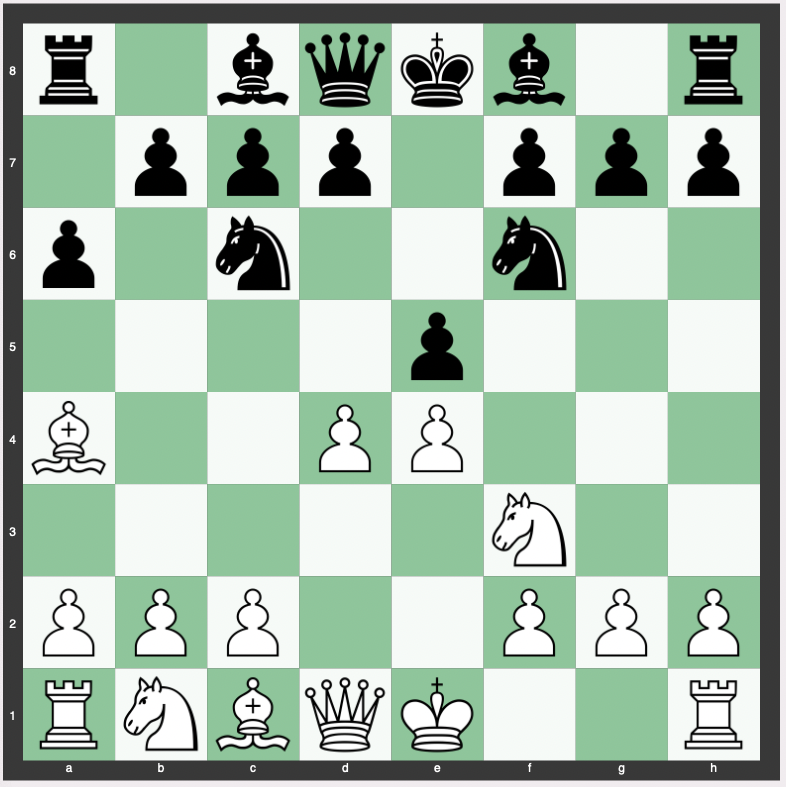Among the Ruy Lopez’s many variations, the Mackenzie Variation holds a special place due to its aggressive and direct approach towards the center control and development of pieces.
Below we look into the Mackenzie Variation of the Ruy Lopez, exploring its move order, theory, strategy, and purpose, as well as its historical significance.
Additionally, we will consider its suitability for beginners or intermediate players and its popularity at the Grandmaster level.
Move Order of the Mackenzie Variation
In the Ruy Lopez, the Mackenzie Variation is a sequence of moves beginning with 1. e4 e5 2. Nf3 Nc6 3. Bb5 a6 4. Ba4 Nf6 5. d4.

This represents a sharp and less common alternative to the more often played 5. O-O (the Closed Defense).
This variation is designed to seize central space immediately with 5. d4, a more aggressive move compared to the usually slow and quiet development in the Ruy Lopez.
Theory, Strategy and Purpose of the Mackenzie Variation
The central purpose of the Mackenzie Variation, like many chess openings, is to gain control of the center, facilitate piece development, and ensure the safety of the king.
The move 5. d4 exd4 aims to control the center, inviting black to capture the pawn.
However, if Black takes the pawn with 5…exd4, White’s knight can recapture on d4, placing a well-centralized knight versus a poorly developed black army.
In some cases, white can also push the pawn with 6. e5, aiming to disrupt black’s piece coordination.
Overall, the Mackenzie Variation relies heavily on tactical possibilities and accurate play.
Sub-Variations of the Mackenzie Variation
There are various responses black can employ against the Mackenzie Variation, leading to different sub-variations.
After 5. d4, black has a few major options: capturing the pawn with 5…exd4, attacking the bishop with b5, or developing the dark-squared bishop to e7.
Each move leads to different types of positions and game structures, allowing players of diverse styles to choose according to their preference.
The primary sequence follows with 5…exd4 (5…Nxe4 6.0-0 transposes to the Open Defense) 6.0-0 (6.e5 Ne4 is harmless) Be7 (6…Nxe4 transposes to the Riga Variation of the Open Defense), leading to the Center Attack (ECO C84) of the Closed Defense.
Generally 5…exd4 is the strongest and provides a small edge for black.
Sample continuations include:
5… exd4 6. O-O Be7 7. e5 Ne4 8. Nxd4 O-O 9. Nf5 d5 10. Nxe7+ Nxe7 11. c3 Nc5 12. Bc2 Bf5 13. Bxf5 Nxf5 14. Nd2 Ne6 15. Nf3 h6 16. Qc2 Ne7 17. Nh4 Nc6 18. Nf3 Qd7 19. Be3 Rfe8 20. Rad1
5… exd4 6. O-O Be7 7. e5 Ne4 8. Nxd4 O-O 9. Nf5 d5 10. Nxe7+ Nxe7 11. c3 Ng6 12. f3 Nc5 13. Bc2 Nxe5 14. b4 Ne6 15. f4 Nc4 16. f5 Ng5 17. f6 Ne4 18. fxg7 Re8 19. Qh5 Ne5 20. h3 Qd6 21. Nd2 Qb6+ 22. Kh2 Qd6
5… exd4 6. O-O Be7 7. e5 Ne4 8. Nxd4 O-O 9. Nf5 d5 10. Nxe7+ Nxe7 11. c3 Nc5 12. Bc2 Bf5 13. Na3 Qd7 14. Be3 Ne6 15. g4 Bxc2 16. Nxc2 f5 17. exf6 Rxf6 18. f4 g6 19. Nd4 Raf8 20. Nxe6 Rxe6 21. Qf3 Re4 22. Rae1 Nc6 23. Qg3 Rfe8 24. Bf2 Qd6 25. Qf3 Rxe1 26. Rxe1 Rxe1+ 27. Bxe1
5… exd4 6. O-O Be7 7. e5 Ne4 8. Nxd4 O-O 9. Nf5 d5 10. Nxe7+ Nxe7 11. c3 Nc5 12. Bc2 Bf5 13. Na3 Qd7 14. Be3 Ne6 15. g4 Bxc2 16. Nxc2 f5 17. exf6 Rxf6 18. f4 g6 19. Nd4 Nxd4 20. Bxd4 Rf7 21. Qf3 Nc6 22. h3 Nxd4 23. cxd4 Raf8 24. Rae1 b6 25. Qf2 Rxf4 26. Qxf4 Rxf4 27. Rxf4
History of the Mackenzie Variation
The Mackenzie Variation is named after George Henry Mackenzie, a Scottish-American chess master of the 19th century.
Mackenzie popularized this aggressive alternative in the Ruy Lopez during his games in the 1870s and 1880s.
While not as popular as some other variations of the Ruy Lopez, the Mackenzie Variation still holds an interesting place in the opening theory due to its dynamic nature.
Is the Mackenzie Variation Good for Beginners or Intermediates?
The Mackenzie Variation can be a good choice for beginners due to its straightforward approach toward central control.
However, it’s crucial to remember that this variation can lead to complex, tactical situations, which might be more suited to intermediate or advanced players.
For intermediates, it can provide a less-trodden path to gain an advantage over opponents who are prepared for more standard Ruy Lopez variations.
How Often Is the Mackenzie Variation Played at the Grandmaster Level?
While the Mackenzie Variation is less common at the Grandmaster level, it’s not unheard of.
Many GMs prefer the Closed Defense or other more traditional lines of the Ruy Lopez due to their solid theoretical grounding.
However, some players do use it as a surprise weapon to throw off an opponent’s preparation or when looking for a complex, tactical battle.
Avoiding well-trodden theory is generally the main reason, as white will throw away their advantage by playing the 1. e4 e5 2. Nf3 Nc6 3. Bb5 a6 4. Ba4 Nf6 5. d4 line.
The Mackenzie Variation is part of the ECO C77 family.
Queen Sacrifice in Ruy Lopez: Morphy Defense, Mackenzie Variation
Conclusion
The Mackenzie Variation of the Ruy Lopez is a fascinating branch of one of the most time-honored openings in chess.
It exemplifies the beauty of the game, showcasing the wide variety of strategies, styles, and surprise elements that chess can offer.
Whether you’re a beginner, an intermediate player, or even a grandmaster, exploring the Mackenzie Variation can open up a new avenue in your chess journey, teaching you about the importance of control over the center, development, tactics, and accurate play.


